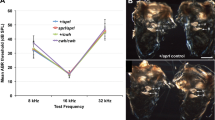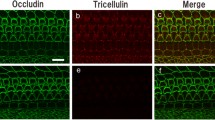Summary
Intraperitoneal injections of cupric chloride prevent neuronal degeneration in the hemizygous brindled motled mouse, MObr/Y, a murine model of kinky hair syndrome (KHS) in humans. At 6–9 months after two i.p. injections, the brain of MObr/Y revealed slightly increased amounts of lipofuscin pigments in the cerebral cortical neurons, cytoplasmic inclusions in the thalamic neurons, and axonal spheroid formation in the tuber cinereum, cerebellum, and brain stem. Increased numbers of mitoses, bizarre hyperchromatic giant nuclei, and numerous clear vacuoles were frequently seen in the proximal renal tubular epithelium. Numerous myelin figures were conspicuous features in these epithelial cells at ultrastructural level. Such changes were not found in the littermate controls but in the heterozygous brindled mottled mouse, MObr/+, identical changes were noted in equal or even higher frequency. These observations suggest that cupric chloride injections effectively modify the expression of the genetic defect in MObr/Y.
Similar content being viewed by others
References
Aguilar MJ, Chadwick DL, Okuyama K, Kamoshita S (1966) Kinky hair disease. I. Clinical and pathological features. J Neuropathol Exp Neurol 25:507–522
Brizzee KR, Ordy JM, Knox C, Jirge SK (1980) Morphology and aging in the brain. In: Pirozzolo J, Maletta GJ (eds) The aging nervous system, advances in neurogerontology, vol 1. Praeger, New York, pp 10–39
Bucknall WE, Haslam RHA, Holtzman NA (1973) Kinky hair syndrome. Response to copper therapy. Pediatrics 52:653–657
Daish P, Wheeler EM, Roberts PF, Jones RD (1978) Menkes' syndrome. Report of a patient treated from 21 days of age with parenteral copper. Arch Dis Child 53:956–966
Danks DM (1977) Copper transport and utilization in Menke's syndrome and in mottled mice. Inorg Persp Biol Med 1:73–100
Danks DM, Campbell PE, Stevens BJ, Mayne V, Cartwright E (1972a) Menkes' kinky hair syndrome. An inherited defect in copper absorption with widespread effects. Pediatrics 50:188–201
Danks DM, Campbell PE, Walker-Smith J, Stevens BJ, Gillespie JM, Blomfield J, Turner B (1972a) Menkes' kinky hair syndrome. Lancet 1:1100–1103
Erdohazi M, Barnes ND, Robinson MJ, Lake BD (1976) Cerebral malformation associated with metabolic disorder. A report of two cases. Acta Neuropathol (Berl) 36:315–325
Garnica AD, Frias JL, Rennert OM (1977) Menkes' kinky hair syndrome: Is it a treatable disorder? Clin Genet 11:154–161
Ghatak NR, Hirano A, Poon TP, French JH (1972) Trichopoliodystrophy. II. Pathological changes in skeletal muscle and nervous system. Arch Neurol 26:60–72
Grover WD, Scrutton MC (1975) Copper infusion therapy in trichopoliodystrophy. J Pediatr 86:216–220
Haywood S (1980) The effect of excess dietary copper on the liver and kidney of the male rat. J Comp Pathol 90:217–232
Hunt DM (1974) Primary defect in copper transport underlies mottled mutants in the mouse. Nature 249:852–854
Hunt DM (1976) A study of copper treatment and tissue copper levels in the murine congenital copper deficiency, mottled. Life Sci 19:1913–1920
Iwata M, Hirano A, French JH (1979) Degeneration of the cerebellar system in X-chromosome linked copper malabsorption. Ann Neurol 5:542–549
Kopp N, Tommasi M, Carrier H, Pialat J, Gilly J, Herne C (1975) Neuropathologie de la trichopoliodystrophie (maladie de Menkes). Une observation anatomo-clinique. Rev Neurol 131: 775–789
Lott IT, Dipaola R, Schwartz D, Janowska S, Kanfer JN (1975) Copper metabolism in the steely hair syndrome. N Engl J Med 292:197–199
Mann JR, Camakaris J, Danks DM (1979) Copper metabolism in mottled mouse mutants. Distribution of64Cu in brindled (MObr) mice. Biochem J 180:613–619
Mann JR, Camakaris J, Danks DM, Walliczek EG (1979) Copper metabolism in mottled mutants, copper therapy of brindled (MObr) mice. Biochem J 180:605–612
Martin JJ, Filament-Durand J, Farriaux JP, Buyssens N, Ketelbant-Balasse P, Jansen C (1978) Menkes' kinky hair disease. A report on its pathology. Acta Neuropathol (Berl) 42:25–32
Matsubara O, Takaoka H, Nasu M, Iwakawa Y, Okada R (1978) An autopsy case of Menkes' kinky hair disease. Acta Pathol Jpn 28:585–594
Menkes JH, Alter M, Steigleder GK, Weakley DR, Sung JH (1962) A sex-linked recessive disorder with retardation of growth, peculiar hair and focal cerebral and cerebellar degeneration. Pediatrics 29:764–779
Nagara H, Yajima K, Suzuki K (1981) The effect of copper supplementation on the brindled mouse. J Neuropathol Exp Neurol 40:428–446
Prins HW, Van den Hamer CJA (1979) Primary biochemical defect in copper metabolism in mice with a recessive X-linked mutation analogous to Menkes' disease in man. J Inorg Biochem 10:19–27
Vagn-Hansen PL, Reske-Nielsen E, Lou HC (1973) Menkes' disease. A new leukodystrophy? A clinical and neuropathological review together with a new case. Acta Neuropathol (Berl) 25:103–119
Van den Hamer CJA, Prins HW, Nooijen JL (1979) Menkes' disease in mottled mice and men. In: Hommes FA (ed) Models for the study of inborn errors of metabolism. Elsevier, Amsterdam, pp 95–102
Vuia O, Heye D (1974) neuropathologic aspects in Menkes' kinky hair disease (trichopoliodystrophy). Neuropaediatrie 5:329–339
Walker-Smith JA, Turner B, Blomfield J, Wise G (1973) Therapeutic implications of copper deficiency in Menkes' steely hair syndrome. Arch Dis Child 48:958–961
Williams RS, Marshall PC, Lott IT, Caviness VS (1978) The cellular pathology of Menkes' steely hair syndrome. Neurology (Minneap) 28:575–583
Yajima K, Suzuki K (1979a) Neuronal degeneration in the brain of the brindled mouse. A light microscope study. J Neuropathol Exp Neurol 38:35–36
Yajima K, Suzuki K (1979b) Neuronal degeneration in the brain of the brindled mouse. An ultrastructural study of the cerebral cortical neurons. Acta Neuropathol (Berl) 45:17–25
Author information
Authors and Affiliations
Additional information
Supported in part by research grants NS-03356, NS-10803, NS-10885, and HD-01799 and a training grant for experimental neuropathology, NS-07098, from the National Institutes of Health, USPHS, USA
Rights and permissions
About this article
Cite this article
Suzuki, K., Nagara, H. Brindled mottled mouse: Morphological changes of brain and visceral organs in hemizygous males following copper supplementation. Acta Neuropathol 55, 251–255 (1981). https://doi.org/10.1007/BF00690986
Received:
Accepted:
Issue Date:
DOI: https://doi.org/10.1007/BF00690986




